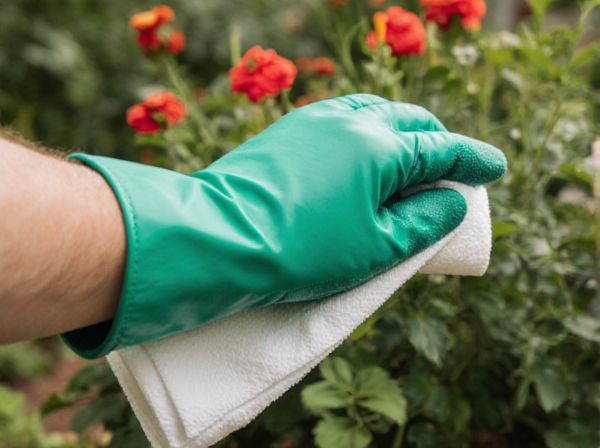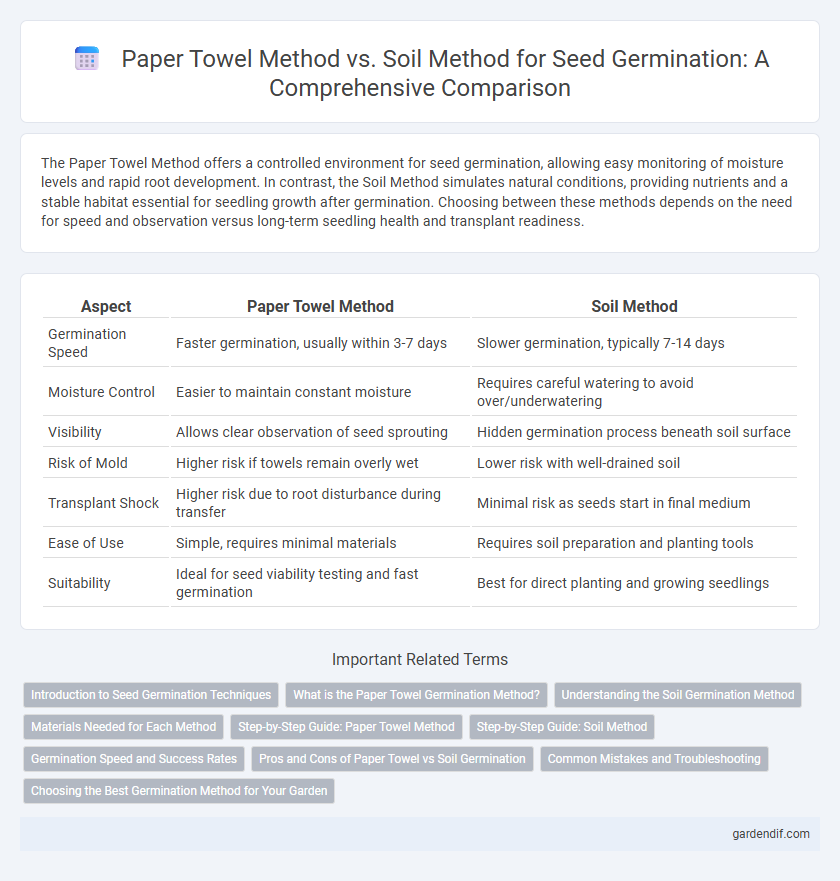
Paper Towel Method vs Soil Method Illustration
The Paper Towel Method offers a controlled environment for seed germination, allowing easy monitoring of moisture levels and rapid root development. In contrast, the Soil Method simulates natural conditions, providing nutrients and a stable habitat essential for seedling growth after germination. Choosing between these methods depends on the need for speed and observation versus long-term seedling health and transplant readiness.
Table of Comparison
| Aspect | Paper Towel Method | Soil Method |
|---|---|---|
| Germination Speed | Faster germination, usually within 3-7 days | Slower germination, typically 7-14 days |
| Moisture Control | Easier to maintain constant moisture | Requires careful watering to avoid over/underwatering |
| Visibility | Allows clear observation of seed sprouting | Hidden germination process beneath soil surface |
| Risk of Mold | Higher risk if towels remain overly wet | Lower risk with well-drained soil |
| Transplant Shock | Higher risk due to root disturbance during transfer | Minimal risk as seeds start in final medium |
| Ease of Use | Simple, requires minimal materials | Requires soil preparation and planting tools |
| Suitability | Ideal for seed viability testing and fast germination | Best for direct planting and growing seedlings |
Introduction to Seed Germination Techniques
The paper towel method accelerates seed germination by maintaining consistent moisture and warmth, making it ideal for monitoring early root development under controlled conditions. In contrast, the soil method mimics natural growing environments, providing essential nutrients and microbial interactions that support seedling growth post-germination. Selecting between these techniques depends on research goals, with the paper towel method favored for rapid assessment and the soil method preferred for holistic plant development studies.
What is the Paper Towel Germination Method?
The paper towel germination method involves placing seeds between moist paper towels to create a controlled and consistent environment for sprouting, ensuring optimal moisture and oxygen levels. This technique allows for easy monitoring of seed germination progress and reduces the risk of diseases associated with soil. It is widely used for its efficiency in testing seed viability and speeding up the early stages of growth before transplanting.
Understanding the Soil Germination Method
The soil germination method offers a natural environment that provides essential nutrients, moisture retention, and aeration necessary for seed development. Seeds planted in well-prepared soil benefit from microbial activity and stable temperature conditions, promoting stronger root systems and healthier seedlings. Compared to the paper towel method, soil germination reduces transplant shock since seeds grow directly in the growing medium, facilitating better adaptation and growth.
Materials Needed for Each Method
The Paper Towel Method requires only basic materials such as paper towels, a spray bottle for moisture, a clear plastic bag for humidity control, and seeds, making it a simple and space-saving option for germination. In contrast, the Soil Method involves potting soil or seed-starting mix, seed trays or pots, water, and often a heat mat to maintain ideal temperature, providing a more natural environment for seed development. Both methods demand clean materials and consistent moisture, but the Soil Method usually offers better nutrient access for seedlings post-germination.
Step-by-Step Guide: Paper Towel Method
Place seeds between two damp paper towels, ensuring they remain moist but not soaked, then seal them in a plastic bag to maintain humidity; keep the setup in a warm, dark place at around 70-75degF (21-24degC) to encourage sprouting. Check daily for signs of germination and mist the towels with water if they start to dry out to prevent seeds from drying out and dying. Once the seeds develop healthy taproots approximately 0.5 to 1 inch long, carefully transfer them to soil to continue growth.
Step-by-Step Guide: Soil Method
The soil method for germination involves filling a seed tray or pots with well-draining seed-starting mix, evenly moistening the soil before planting seeds at the recommended depth to ensure proper root development. Cover the seeds lightly with soil, maintain consistent moisture by watering gently, and keep the container in a warm, well-lit area with temperatures between 65-75degF to promote optimal germination rates. Regular monitoring for soil moisture and signs of sprouting allows timely thinning of seedlings to prevent overcrowding and supports healthy growth.
Germination Speed and Success Rates
The Paper Towel Method typically accelerates germination speed by providing a controlled, moist environment that promotes rapid seed sprouting within 2-7 days. In contrast, the Soil Method often results in slower germination, ranging from 7-14 days, due to variable moisture and temperature conditions. Success rates tend to be higher with the Paper Towel Method, averaging around 85-95%, compared to the Soil Method's 70-85% depending on soil quality and environmental factors.
Pros and Cons of Paper Towel vs Soil Germination
The paper towel method offers rapid germination and easy monitoring of seed development, reducing the risk of overwatering and soil-borne diseases, but it lacks the natural nutrients and root support found in soil. Soil germination provides a more realistic growing environment with beneficial microorganisms and essential nutrients, promoting healthier seedling growth, yet it requires careful moisture control and can be slower to show visible germination progress. Choosing paper towels enables controlled conditions and quick assessment, while soil fosters robust root establishment crucial for long-term plant health.
Common Mistakes and Troubleshooting
Common mistakes in the Paper Towel Method include over-saturating towels, leading to mold growth, and inconsistent moisture levels that hinder seed sprouting. In the Soil Method, poor drainage and compacted soil often prevent seed roots from penetrating, causing slow or failed germination. Ensuring proper moisture balance in paper towels and using well-aerated, loose soil with adequate drainage can significantly improve germination success rates.
Choosing the Best Germination Method for Your Garden
The Paper Towel Method accelerates seed germination by providing controlled moisture and visibility, ideal for closely monitoring seed sprouting and ensuring uniformity. The Soil Method mimics natural conditions, promoting stronger root development and better adaptation to garden environments, crucial for robust seedling growth. Selecting the best germination method depends on specific plant species, available resources, and the gardener's ability to maintain optimal moisture and temperature conditions.
Paper Towel Method vs Soil Method Infographic

 gardendif.com
gardendif.com